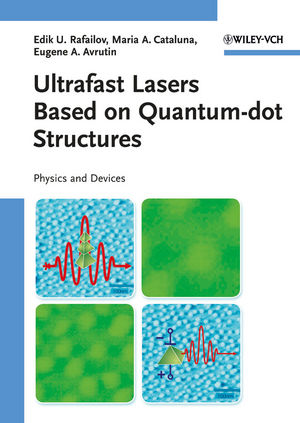Ultrafast Lasers Based on Quantum Dot Structures: Physics and DevicesISBN: 978-3-527-40928-0
Hardcover
262 pages
March 2011
 |
||||||
Eugene Avrutin has been working in the field of theory, numerical modelling, and computer-added design of semiconductor optoelectronic devices since 1986. Having previously been a researcher at the A.F. Ioffe Institute, St Petersburg (till 1993), and a research assistant in the University of Glasgow (1994-1999), he has held an academic position at the University of York since 2000. He has published two book chapters, more than 70 peer-reviewed journal papers and over a hundred conference papers, many of them in the field of fast and ultrafast laser sources and/or reduced dimensionality semiconductors.
Maria Ana Cataluna is a lecturer and a Royal Academy of Engineering/EPSRC Research Fellow at the University of Dundee (UK). She has been committed to research in ultrafast laser physics and technology development since 2000, having previously worked at the Instituto Superior Técnico, Portugal (2000-2002), at the University of St. Andrews, UK (2003-2007), subsequently joining the University of Dundee in 2007. She was awarded the IEEE Photonics Society Graduate Student Fellowship (2007), for her work on innovative mode-locking regimes in ultrafast quantum-dot based lasers. She has published more than 50 papers in peer-reviewed journals and conference proceedings and three invited book chapters.
Edik Rafailov has been engaged in the research and development of high-power cw and ultrashort pulse lasers, nonlinear and integrated optics since 1987. In 2005 he moved to Dundee University as a lecturer and established a new Photonics and Nanoscience group. In 2008 he became a reader and two years later a professor. He was previously a senior researcher at Ioffe Institute, St Petersburg (1987-1997) and a research fellow at the University of St. Andrews (1997-2005). He has authored and co-authored over 220 articles in refereed journals and conference proceedings, three invited chapters and numerous invited talks to CLEO, SPIE and LEOS. He also holds 8 UK and two US patents. Professor Rafailov is the coordinator of projects funded by EU FP7 program and EPSRC. His current research interests include novel high-power CW, short, ultrashort-pulse and high-repetition rate lasers; generation of UV/visible/IR and THz radiation, nano-structures; nonlinear optics and Biophotonics.
Maria Ana Cataluna is a lecturer and a Royal Academy of Engineering/EPSRC Research Fellow at the University of Dundee (UK). She has been committed to research in ultrafast laser physics and technology development since 2000, having previously worked at the Instituto Superior Técnico, Portugal (2000-2002), at the University of St. Andrews, UK (2003-2007), subsequently joining the University of Dundee in 2007. She was awarded the IEEE Photonics Society Graduate Student Fellowship (2007), for her work on innovative mode-locking regimes in ultrafast quantum-dot based lasers. She has published more than 50 papers in peer-reviewed journals and conference proceedings and three invited book chapters.
Edik Rafailov has been engaged in the research and development of high-power cw and ultrashort pulse lasers, nonlinear and integrated optics since 1987. In 2005 he moved to Dundee University as a lecturer and established a new Photonics and Nanoscience group. In 2008 he became a reader and two years later a professor. He was previously a senior researcher at Ioffe Institute, St Petersburg (1987-1997) and a research fellow at the University of St. Andrews (1997-2005). He has authored and co-authored over 220 articles in refereed journals and conference proceedings, three invited chapters and numerous invited talks to CLEO, SPIE and LEOS. He also holds 8 UK and two US patents. Professor Rafailov is the coordinator of projects funded by EU FP7 program and EPSRC. His current research interests include novel high-power CW, short, ultrashort-pulse and high-repetition rate lasers; generation of UV/visible/IR and THz radiation, nano-structures; nonlinear optics and Biophotonics.



